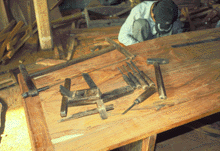
Woodworking in Vietnam
Introduction
Vietnam offers visitors a rare opportunity to see traditional crafts and agricultural still practiced on a national scale. Minutes away from Hanoi's Noi Bai International Airport, you can see rice paddies farmed the traditional way, with plows pulled by water buffalo and farmers bent double from the labor. A motorized plow is a rare sight indeed in the Vietnam's green rice fields.
Power tools are also unusual sights. Hand tools are used throughout the country for all kinds of woodwork, even in large, professional workshops. Once in a while you'll see the odd primitive circular saw, or an electric drill. But these are the exceptions. Most work is done by hand, using the same tools and the same techniques that existed in Vietnam for a thousand years.
That having been said, Vietnam is changing rapidly, and these observations about the country may not hold true in five years. What is most interesting is how similar Vietnamese workshops, tools and practices are to what existed in the West before the invention of stationary woodworking machinery (around the time of the American Civil War).
Many of us in the West tend to be more familiar with Japan's rich woodworking traditions than we are with China's, and we may tend to assume that Japanese tools and styles are found everywhere in Asia. I could immediately see that in Vietnam this is not the case. The country's woodworking tools, technologies and especially its crafted products (such as its ornate furniture) show the influence of its powerful next-door neighbor, China. But Vietnam's strong cultural traditions make its woodcraft its own.
Vietnam is an impoverished country, yet one with strikingly high levels of literacy and employment. The "traditional" methods and tools of farming, woodwork and other professions are either antiquated or classic, depending on one's perspective. But one thing that is certain is that such tools and methods demand a high level of participation from the workforce. "You will never see harder-working people," commented one tourist from New York City.
The following exhibit, "Woodworking in Vietnam," may raise many more questions than it answers. I speak no Vietnamese, and the guides and travel books were of limited assistance in translating the technical vocabulary of woodworking. Because of this, I could not gather information about every tool or craft style that interested me. But despite these limitations, "Woodworking in Vietnam" may be the most comprehensive exhibit on the subject ever published in English. I hope the exhibit will intrigue its viewers and inspire further research in the future.
I would like to thank Jonathan Bloom for encouraging me to travel to Vietnam and for use of his woodcarving in this exhibit. Thanks are also due to Annett for her acute visual and technical skills. Finally, I would like to thank the many people in Vietnam who extended their hospitality to me.
Click on the picture to enlarge
Copyright 1999 01 Inc., NYC